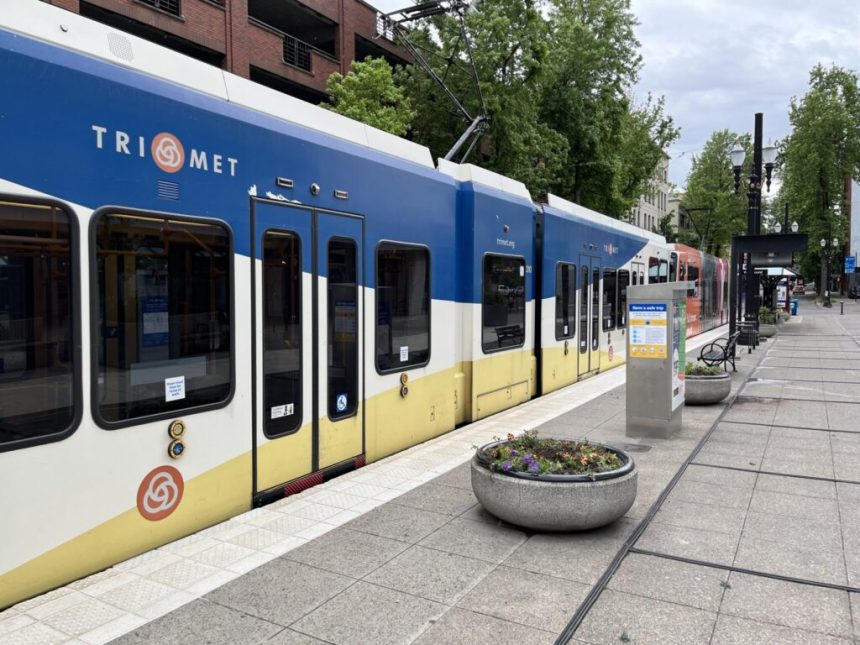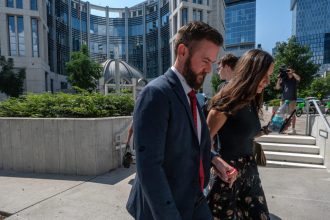The transit agency for the Portland, Ore., area, Tri-Met, announced it would eliminate up to eight bus lines as well as reduce the frequency of service on other lines as soon as November. States face uncertain federal funding as the Trump administration reduces the size of government and zeroes out some Biden-era transportation programs. (Photo courtesy of the Oregon Department of Transportation)
States are scrambling for the money to fill potholes, plow roads, maintain bridges and pay bus drivers as they confront inflation- and tariff-driven cost increases and declining gas tax revenues.
States also face uncertain federal funding as the Trump administration reduces the size of government and zeroes out some Biden-era transportation programs. As the Infrastructure Investment and Jobs Act expires next year and Congress considers its next transportation funding bill, cities are clamoring for the federal government to bypass states and give cities a larger share of federal infrastructure money distributed by formula.
Drivers will have to pay higher vehicle registration fees and gas taxes to make up for the shortfalls. Long-planned construction projects and safety improvements will be delayed. And bus riders may see fewer routes and longer wait times.
The chaos in a pair of state legislatures on either side of the country illustrates the dire state of highways and transit systems – and might foretell a bumpy road ahead.
In Oregon, nearly 500 transportation employees, about 10% of the department’s workforce, might lose their jobs as state lawmakers consider a transportation funding bill in a special legislative session. The political balance is so delicate that lawmakers have delayed a vote on a $4.3 billion transportation package for more than two weeks while a Democratic state senator recovers from surgery; his vote is necessary to pass the funding measure, a tax increase that requires a supermajority. The Senate is now expected to vote on Sept. 29.
And in Pennsylvania, a budget impasse over transit funding between the state’s Republican-dominated Senate and Democrat-led House continues. Philadelphia’s transit system, SEPTA, has said it will reverse deep cuts that threatened a near-shutdown of the buses and trains in one of the country’s largest transit systems.
The move, approved by Democratic Gov. Josh Shapiro, allows the transit agency to shift $394 million from capital funding to operational expenses for the next two years.
Shapiro said he acted after he learned there was a 63% increase in late arrivals to Philadelphia schools when the service cuts began, according to the Pennsylvania Capital-Star.
“It was just clear to me that is not something we can allow to continue,” Shapiro said at a news conference.
Pandemic-era funding ends
Pennsylvania and other states are confronting the end of pandemic-era federal funding that kept transit systems afloat. The so-called fiscal cliff threatens to bring about fare hikes and service cuts to bus and rail systems in both big cities and rural America in the coming years. To address the shortfalls, many states are, like SEPTA, shifting money that was earmarked for capital investment toward operating expenses.
“It’s financial gymnastics,” said Joe Kane, a fellow at the left-leaning Brookings Institution who studies transportation issues. “We fundamentally as a country have a challenge in reliably and durably having a revenue source to pay for these improvements across the country. It’s put even more pressure on states and localities to cobble together the resources — however and wherever they can — to make up for some of those gaps.”
The funding crisis has been particularly drastic for the country’s transit systems, said Corrigan Salerno, a policy manager at Transportation for America, an advocacy organization for safe transit. Ridership hasn’t fully recovered from pandemic-era declines, he said, meaning that transit agencies aren’t collecting as many fares as they did before 2020. The cost of labor, parts, software and fuel to maintain and operate transit systems has exceeded inflation, too.
We fundamentally as a country have a challenge in reliably and durably having a revenue source to pay for these improvements across the country.
– Joe Kane, a fellow at the Brookings Institution who studies transportation issues
Without high-quality or frequent-enough service, buses and trains are unable to attract riders, he said. Service cuts and fare hikes can make the system less attractive to riders, as well as bring in less money from riders.
“And that’s really the nature of the fiscal cliff and the death spiral that transit agencies are really trying so desperately to avoid,” Salerno said. “Because once they have to make these service cuts to square their budgets, people are going to stop riding some of these systems.”
Chicago; San Francisco; Seattle; Tucson, Arizona, and the state of Rhode Island have all faced transit funding gaps in recent months, Salerno said. In North Carolina, voters will consider a ballot measure in November to increase a local sales tax to support transit and road improvements in Charlotte, the state’s biggest city. In California, local transit agencies are seeking temporary operating loans from the state.
Eliminating bus routes
In Oregon, lawmakers have been at work on a transportation bill for several years, but the funding crisis came to a head after the legislature failed to pass a new spending plan before the end of the regular legislative session in June.
The state’s Department of Transportation faced an immediate $300 million shortfall in the two-year budget cycle that began July 1. The transit agency for the Portland area, Tri-Met, announced it would eliminate up to eight bus lines as well as reduce the frequency of service on other lines as soon as November.
Oregon Gov. Tina Kotek, a Democrat, announced this summer that the state would lay off 483 transportation workers and close a dozen maintenance facilities. Among those who may lose their jobs are programmers who maintain software for Driver & Motor Vehicle Services, and maintenance workers who stripe roads, clear brush, and clean up graffiti and debris.
Kotek pushed back the layoffs after House lawmakers passed a new funding plan during a special session that began in September. But if the Senate fails to approve the measure, the layoffs are scheduled for Oct. 15.
The transportation package would raise the state gas tax by six cents a gallon, increase vehicle title and registration fees, and temporarily double a statewide payroll tax for transit from 0.1% to 0.2%, according to the Oregon Capital Chronicle.
The legislation would allow the payroll tax to sunset in 2028, a move that critics warn will force the state, once again, to confront how to avoid cuts to bus service. It also requires electric vehicle drivers to pay a mileage fee to support road maintenance, a move that could dampen EV sales, but that captures some of the gas tax revenue lost to the transition to electric cars.
Without new funding in Oregon, local road departments will continue to face impossible choices that lead to reduced services and delayed implementation of safety projects, said Lamar Wise, the political director for Oregon AFSCME, the union representing 850 road workers, engineers and surveyors in the state. Failure to increase taxes and fees means asking fewer workers “to do more with less,” putting their safety and the driving public at risk, Wise told a legislative committee in August, as it considered the transportation package.
“It is about keeping our roads safe and ensuring that the public can count on reliable transportation in every corner of the state,” Wise said.
In Portland, the state’s largest city, it’s impossible to absorb more cuts to service, Mayor Keith Wilson told the same panel. If lawmakers don’t pass a spending plan, the city will likely lose 50 transportation staffers who repair streetlights, upgrade traffic signals and manage construction projects. The city bureau has faced cuts each of the past seven years, Wilson said.
“If you drive down the streets of Portland, or ride on a bus or a bike, the roads under your tires are crumbling,” he said.
But Jake Seavert, a county commissioner in Union County, a rural county of 26,000 in Eastern Oregon, told lawmakers that his constituents object to the spending plan, particularly the increase in fuel taxes and registration fees. The hike in annual registration fees places an undue burden on businesses and rural families who require multiple vehicles, he testified.
Oregon’s Department of Transportation must look for efficiencies, Seavert said, a nod to the Trump administration’s lacerating cuts to federal jobs and spending.
“Do more with less,” Seavert said.









